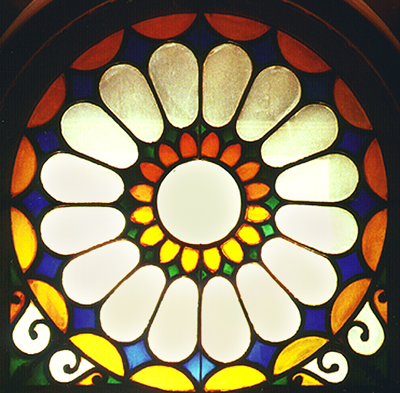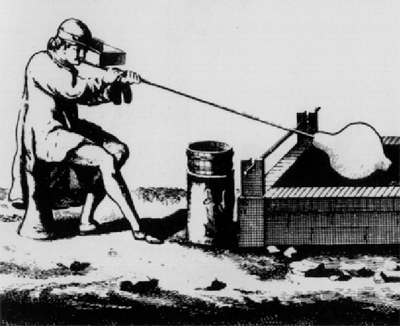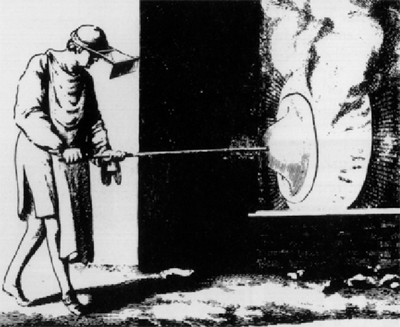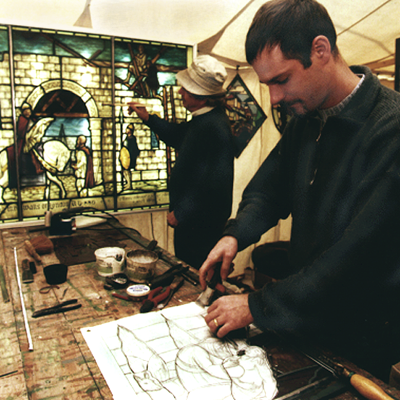Glass
The principle ingredient for the manufacture of glass is silica, the most common source of which is sand. One of the recurring themes in the history of glass has been the search for sources of sand that are free of contaminating oxides. Just one gram of iron oxide in a ton of silica will give the glass a green tint. A second major challenge has been the identification of appropriate fluxes with which to melt silica at achievable temperatures. A recipe from the 1770s used flint ‘glass’, purified pot ash and red lead, whilst one from the 1830s recommended six molecular parts of silica and one part each of sodium, calcium and magnesium oxides. The third challenge has been to develop technologies that would produce large, clear, glass sheet.

Above: Stained glass window in the hall of 13 Brunswick Square.
By the Regency several methods were known for making glass for glazing, including cylinder glass, broad sheet glass and crown glass technologies. Additionally, by this period it was possible to manufacture glass plate, a process undertaken by the British Cast Plate Glass Company who, in 1789, began using a machine powered by steam to grind and polish plate glass for use in mirrors, coaches and the homes of the extremely wealthy.
The glazier fits the panes of glass to the window frame, usually before the window is installed within the building. The glass is fitted using putty which is then painted to blend with the surrounding joinery.
Broad sheet glass
Broad sheet glass was first made in Sussex in 1226, but was of poor quality and fairly opaque. The process involves gathering molten glass onto a ‘blowpipe’ and then creating an elongated balloon shape. The two ends are cut off and the cylinder that is left is split with shears while still hot and flattened out on an iron plate. Glass made in this way had a rough surface and was not always transparent.
Crown glass
Crown glass was introduced to London from France in 1678. From 1700 to 1840, it was the main method of manufacture. It was a highly skilled process producing a superior quality product. In this process the glass maker gathered molten glass on the end of a blow pipe, and then formed it into a globe by reheating, rotating and blowing. When it was the right size an iron rod called a ‘pontil' or ‘punty' was attached at the base of the globe to crack it from the blowpipe. The globe was then reheated and rotated at considerable speed, causing it to be spun out into a flat disc or ‘table', about five feet in diameter. These discs were placed in a kiln to strengthen and then cooled to remove the stresses built up during manufacture.

Above: Glazier blowing crown glass
The finished disks had a ‘bull’s eye’ or ‘bullion’ in the centre where the pontil had been attached. This was usually discarded after the glass table had been cut into sheets for the glazing of Georgian windows, although occasionally it was used as a cheap glazing material. Crown glass is distinguished by its delicate traces of circular ‘ream’, the ripples caused by the spinning action during manufacture.
During the 18th century crown glass became increasingly popular and, by the 1780s, it was by far the most widely used. A situation helped by the revenue tax on glass manufacture favouring its production. The repeal of this tax in 1845 and the increasing popularity of plate glass saw a massive reduction in the commissioning in crown output. As William Cooper’s cutting guide of 1835 indicates, the maximum size of a crown glass pane was restricted to approximately 22, this being a little less than the radius of the crown table or disk. It is this limited size of glass pane that necessitated the use of glazing bars within the Georgian window.
There is little crown glass to be found in windows these days, both due to its fragility and the later trend to replace its small panes with those of larger and more fashionable cylinder glass. Crown glass is irreplaceable; its manufacture is a lost skill and therefor the conservation of the panes which remain is vital.

Above: spinning crown glass
Cylinder glass
Cylinder glass was introduced into England from continental Europe in 1832. Just two years later Robert Lucas Chance presented an improved cylinder sheet, with larger panes of finer quality. His process involved molten glass being blown into a cylindrical wooden mould. This glass was then re-heated, blown, rotated and swung over a trench until a cylinder was formed inside the mould. Glass made in this way has a gentle wavy reflection. It is of a lesser quality than crown glass, and has by now replaced it in most eighteenth and nineteenth century windows.
Stained glass
Stained Glass can be made by the addition of metallic oxides to the molten glass, with different oxides producing different colour stains; for example, cobalt oxide produces blue and copper oxide, green. The addition of a small amount of gold to the molten glass produces a deep ruby colour In addition to, or instead of, the stain being within the glass itself, the surface can be painted using mixtures of powdered glass and other substances.
'Matt painting' is the use of a wash of paint to modify the colour of the glass with shadowing and highlighting. ‘Trace painting' is where an opaque paint is used to draw outlines, usually following a pattern placed under the glass. In the ‘mosaic' method of stained glass window construction, individual pieces of glass of different colours are combined in a design. They are fitted into leads which are soldered together, the completed window having an outline of lead 'came'.

By the eighteenth century, the art of glass painting had declined to the point where a china painter was likely to be employed to paint glass for a stained glass window. However, the early nineteenth century was a period of revival for stained glass. There was renewed interest in methods of production and in its use in architecture.
If you are interested in further reading on this topic, these links will provide you with more information:
Sash Windows London; History of window glass manufacturing
'Making tubes and sheets of glass' by Mike Firth
The London Crown Glass Company; manufacturing techniques
Brief history of period window glass
Alan McFarlane's video demonstration of blowing and spinning crown glass
Building Conservations; 'Plain Glazing' by Ben Sinclair
Bendheim Restoration Glass' historical traditions in manufacturing antique glass
Tatra Glass; manufacturing stained glass


